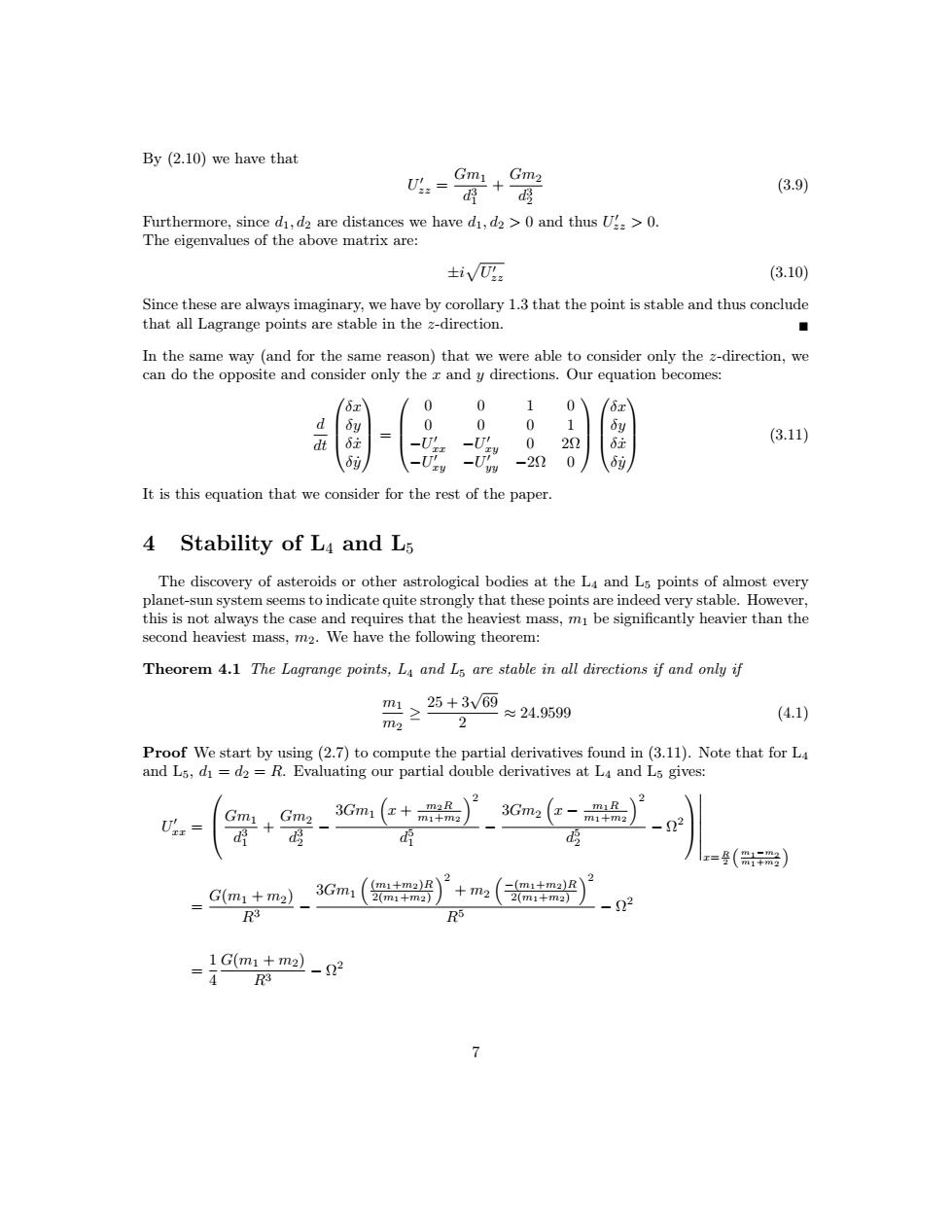正在加载图片...

By (2.10)we have that U2= Gmi Gm2 d d (3.9) Furthermore,since di,d2 are distances we have di,d2>0 and thus U'>0. The eigenvalues of the above matrix are: ±iV0g (3.10) Since these are always imaginary,we have by corollary 1.3 that the point is stable and thus conclude that all Lagrange points are stable in the z-direction. ■ In the same way (and for the same reason)that we were able to consider only the z-direction,we can do the opposite and consider only the x and y directions.Our equation becomes: Ox 0 0 0 Ox d 0 0 0 1 dt -U -UJ 0 22 6 (3.11) oy Iy -22 0 67 It is this equation that we consider for the rest of the paper. 4 Stability of L4 and L5 The discovery of asteroids or other astrological bodies at the L4 and L5 points of almost every planet-sun system seems to indicate quite strongly that these points are indeed very stable.However, this is not always the case and requires that the heaviest mass,mI be significantly heavier than the second heaviest mass,m2.We have the following theorem: Theorem 4.1 The Lagrange points,La and Ls are stable in all directions if and only if m1≥ 25+3V69 ≈24.9599 m2 2 (4.1) Proof We start by using(2.7)to compute the partial derivatives found in(3.11).Note that for L4 and L5,d=d2=R.Evaluating our partial double derivatives at L4 and Ls gives: 2 Gm2 3Gm(c+品)】 3Gm2(x- miR m1+m2 -22 d d d =(品)》 2 G(m1+m2) 3Gm1 (m1+m2)R +m2 -(m1+m2)R 2(n1+m2) 2(m1+m2) R3 R6 1G(m1+m2-02 4 R 7By (2.10) we have that U 0 zz = Gm1 d 3 1 + Gm2 d 3 2 (3.9) Furthermore, since d1, d2 are distances we have d1, d2 > 0 and thus U 0 zz > 0. The eigenvalues of the above matrix are: ±i p U0 zz (3.10) Since these are always imaginary, we have by corollary 1.3 that the point is stable and thus conclude that all Lagrange points are stable in the z-direction. . In the same way (and for the same reason) that we were able to consider only the z-direction, we can do the opposite and consider only the x and y directions. Our equation becomes: d dt δx δy δx˙ δy˙ = 0 0 1 0 0 0 0 1 −U 0 xx −U 0 xy 0 2Ω −U 0 xy −U 0 yy −2Ω 0 δx δy δx˙ δy˙ (3.11) It is this equation that we consider for the rest of the paper. 4 Stability of L4 and L5 The discovery of asteroids or other astrological bodies at the L4 and L5 points of almost every planet-sun system seems to indicate quite strongly that these points are indeed very stable. However, this is not always the case and requires that the heaviest mass, m1 be significantly heavier than the second heaviest mass, m2. We have the following theorem: Theorem 4.1 The Lagrange points, L4 and L5 are stable in all directions if and only if m1 m2 ≥ 25 + 3√ 69 2 ≈ 24.9599 (4.1) Proof We start by using (2.7) to compute the partial derivatives found in (3.11). Note that for L4 and L5, d1 = d2 = R. Evaluating our partial double derivatives at L4 and L5 gives: U 0 xx = Gm1 d 3 1 + Gm2 d 3 2 − 3Gm1 x + m2R m1+m2 2 d 5 1 − 3Gm2 x − m1R m1+m2 2 d 5 2 − Ω 2
x= R 2 m1−m2 m1+m2 = G(m1 + m2) R3 − 3Gm1 (m1+m2)R 2(m1+m2) 2 + m2 −(m1+m2)R 2(m1+m2) 2 R5 − Ω 2 = 1 4 G(m1 + m2) R3 − Ω 2 7